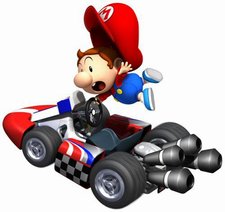 More than two decades of verification have solidified it as truth, but given the absurd quality of recent software, it seems worth reiteration; the best titles on Nintendo’s console have been first-party Nintendo games.
More than two decades of verification have solidified it as truth, but given the absurd quality of recent software, it seems worth reiteration; the best titles on Nintendo’s console have been first-party Nintendo games.
Whether pushing innovation with Wii Sports and Wii Fit or polishing the established with Twilight Princess, Super Mario Galaxy and Super Smash Bros. Brawl, the Kyoto-based gaming juggernaut has shown an unflinching, relentless attention to detail on its own Wii titles.
Given Nintendo’s impressive Wii track record and the post-DS resurrection of interest in the franchise, the recently released Mario Kart Wii has been one of the most hotly anticipated Wii titles of the year. 2005’s Mario Kart DS reestablished Nintendo’s long-running racer as one of gaming’s premier franchises, so lofty expectations seem a natural application for any new Mario Kart title. Fans will be pleased to know Nintendo has, in most respects, gone above-and-beyond their ivory-coated suppositions for Mario Kart Wii.
But players should be forewarned; Mario Kart Wii often frustrates and disappoints almost as wholeheartedly as it thrills. Veteran kart aficionados, in particular, may be dispirited by Nintendo’s insistence on rewarding the tenderfoots and punishing the skilled.
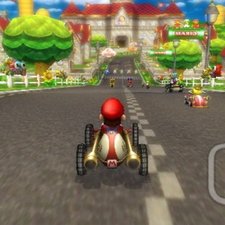 Little has changed in regard to the core Mario Kart experience for the move to Wii. Sixteen years and five exorbitantly high-selling sequels have passed since the release of the Super NES original, allowing Nintendo to fine-tune the established Mario Kart formula to near-perfection. Players select a driver from a list of beloved Mario characters and hop behind the wheels of outrageously designed go-kart racers. As the checkered flag drops, a frantic race through wacky Nintendo environments ensues, and players have three laps to establish and maintain a lead, meanwhile assaulting other drivers with everything from banana peels to Koopa shells and dodging a bombardment of incoming attacks.
Little has changed in regard to the core Mario Kart experience for the move to Wii. Sixteen years and five exorbitantly high-selling sequels have passed since the release of the Super NES original, allowing Nintendo to fine-tune the established Mario Kart formula to near-perfection. Players select a driver from a list of beloved Mario characters and hop behind the wheels of outrageously designed go-kart racers. As the checkered flag drops, a frantic race through wacky Nintendo environments ensues, and players have three laps to establish and maintain a lead, meanwhile assaulting other drivers with everything from banana peels to Koopa shells and dodging a bombardment of incoming attacks.
The premise oozes nutty, unmistakably “Nintendo” absurdity. Mario Kart can initially seem a strange, incompatible fighter/racer hybrid in concept, but it has always focused on an unrivaled marriage between wild ideas and superior gameplay. While some things have changed over time, Mario Kart’s reputation as a multiplayer extravaganza of the highest order has not. But behind the veil of cartoon lunacy and first-place happenstance, sophisticated and technique-driven racing mechanics have always operated as the driving force — no pun intended — behind any good Mario Kart experience.
Such is not entirely the case with Mario Kart Wii, but we’ll get into that later.
Nintendo has clearly taken a “more is better” approach to its flagship racer, as Mario Kart Wii is certainly the biggest Mario Kart game to date. The game’s massiveness is most apparent in its course selection; Mario Kart Wii offers 32 courses spanning eight different Grand Prix cups, more than in any console-based Mario Kart before. The Grand Prix template is similar to Mario Kart DS; 16 of the courses are new, while 16 are beautiful remakes of courses from past Mario Kart games. While the renovated retro courses are a treat to revisit, the highlights of Mario Kart Wii are the new tracks.
As with Mario Kart games prior, most of the tracks in the easier cups boast a simple design. Mario Kart Wii’s Mushroom Cup courses maintain this credo, sacrificing complexity for simple elegance and charm. Things pick up a bit with the Flower Cup; Mario Circuit is one of the prettiest, most vibrantly colorful courses in the game, while Coconut Mall and Wario’s Gold Mine are destined to become Mario Kart classics. Yet while the Star Cup continues to ramp the racing intensity, none of its tracks are especially memorable, save for some exhilarating twists-and-turns in Koopa Cape and the unexpected, gorgeous Maple Treeway.
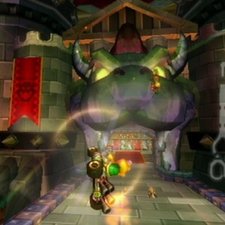 But the Special Cup absolutely steals the show. Not only does it entirely justify the game’s purchase from a single-player perspective, but it is also one of the finest Grand Prix cups in the franchise’s storied history. The twisting Dry Dry Ruins is one of the most enjoyable desert-themed Mario Kart courses ever, while Moonview Highway builds upon the great ideas from past roadway tracks and provides the most frantic traffic-dodging course in the history of the series. But the final two courses really push the envelope; Bowser’s Castle and Rainbow Road are a devastating back-to-back combo of gorgeous visuals, beautiful effects and insane track design, easily the best of each of their respective recurring Mario Kart courses.
But the Special Cup absolutely steals the show. Not only does it entirely justify the game’s purchase from a single-player perspective, but it is also one of the finest Grand Prix cups in the franchise’s storied history. The twisting Dry Dry Ruins is one of the most enjoyable desert-themed Mario Kart courses ever, while Moonview Highway builds upon the great ideas from past roadway tracks and provides the most frantic traffic-dodging course in the history of the series. But the final two courses really push the envelope; Bowser’s Castle and Rainbow Road are a devastating back-to-back combo of gorgeous visuals, beautiful effects and insane track design, easily the best of each of their respective recurring Mario Kart courses.
This “grand finale” is somewhat bittersweet, though; just as Mario Kart Wii gains some serious steam in terms of inventive track design, it runs out of new courses to offer.
While the tracks themselves are perhaps the most important aspect of any Mario Kart experience, control is perhaps even more critical to any Wii experience. For Mario Kart Wii, Nintendo has released another gimmicky peripheral for the Wii remote; a hollow plastic “Wii Wheel” in which the Wii remote is placed. The game controls similar to Nintendo’s Wii launch racer Excitetruck, asking players to steer their carts by tilting the Wii remote, done with the Wii Wheel by simply mimicking real-life steering. Items are deployed by pressing the B button, accessible on the back of the Wii Wheel.
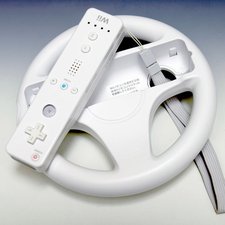 Like most gamers, I chuckled at Nintendo’s announcement of the Wii Wheel. With the gimmicky, gameplay-hindering Wii Zapper still fresh in the collective gaming consciousness, most expected the Wii Wheel to result in a similar $20 pocket-robbing travesty. But surprisingly, the Wii Wheel actually adds far more to the Mario Kart experience than it detracts.
Like most gamers, I chuckled at Nintendo’s announcement of the Wii Wheel. With the gimmicky, gameplay-hindering Wii Zapper still fresh in the collective gaming consciousness, most expected the Wii Wheel to result in a similar $20 pocket-robbing travesty. But surprisingly, the Wii Wheel actually adds far more to the Mario Kart experience than it detracts.
Make no mistake, experienced players will likely try the Wii Wheel, scoff at its gimmicky implementation and, as quickly as a 150cc Mushroom Cup run, switch back to the GameCube controller; as is the case with Brawl, it is still the most precise control option. But casual gamers and those less focused on record-breaking lap times will love the Wii Wheel, and justifiably so. Something about holding it just feels more natural than tilting a horizontal remote; it adds not only a degree of precision, but also genuine fun to the already-hysterical Mario Kart Wii. It is a far better control method than most expected not only for Mario Kart, but any similarly-controlled Wii racer. With its release, the Wii Wheel has also made some older Wii games much more intuitive and fun, as well as a lot easier to control.
Excitetruck, I’m looking at you.
In keeping with the recent trend of including a few thousand control options in Wii games, Mario Kart Wii can also be played with the Wii remote and nunchuk combination and the Classic Controller, as well. No matter how players prefer to handle their kart, Mario Kart Wii makes appropriate accommodation.
But while I’ve dealt it mostly praise thus far, there are some serious criticisms to levy against Mario Kart Wii, specifically in terms of its vicious, inequitable “rubberbanding” habit.
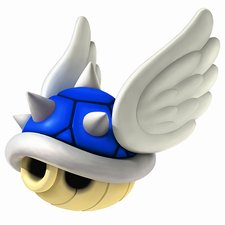 Some fans have been calling for an item editor in Mario Kart for years, and in light of the ruthless Wii iteration, the need for such an option has never been more apparent. While there has always been an aspect of uncertainty to climbing ahead of the pack in a Mario Kart race, doing so in Mario Kart Wii’s 150cc Grand Prix almost guarantees you a few dozen consecutive shells to the head. While, at the very least, all items can be turned off in the single and multiplayer versus mode, no such option is available for Grand Prix racing, when rubberbanding is at its villainous worst.
Some fans have been calling for an item editor in Mario Kart for years, and in light of the ruthless Wii iteration, the need for such an option has never been more apparent. While there has always been an aspect of uncertainty to climbing ahead of the pack in a Mario Kart race, doing so in Mario Kart Wii’s 150cc Grand Prix almost guarantees you a few dozen consecutive shells to the head. While, at the very least, all items can be turned off in the single and multiplayer versus mode, no such option is available for Grand Prix racing, when rubberbanding is at its villainous worst.
There is certainly something to be said for keeping things competitive. But when doing so comes at the cost of punishing experienced players and rendering them helpless, it becomes a serious flaw. In Mario Kart Wii, a player can literally hug each corner, hit each speed boost, nail every shortcut and run a flawless race, yet finish in last place thanks to an endless barrage of shells and lightning bolts. Some have justly pointed out that Mario Kart Wii’s increased number of racing participants — 12 per race, four more than usual — and the addition of more all-racer-affecting items, such as the POW Block, result in a simple conclusion: with more drivers and more items, players can only expect to be clobbered more often. But these additions and my widespread criticism are not mutually exclusive. While racer and item additions are certainly part of the issue, the problem is further intensified by some of the cheapest rubberbanding AI in the history of the series.
Keeping things close is one thing. Sacrificing skill for sheer luck is another. Nintendo found the balance in past Mario Kart games, but has unfortunately tipped the scales on Wii.
Speaking of unfortunate occurrences, while Mario Kart Wii boasts several different single and multiplayer racing modes, the local offline multiplayer is tragically watered down. Gamers playing at home with friends can expect to get down with a split-screen versus mode that takes a noticeable drop to 30 frames per second and a gimped battle mode restricting players to team-play only. Inexplicably, the local multiplayer Grand Prix has also been completely removed. At least for me, gathering around a pizza and some Mario Kart with friends in the living room has always been an inevitable appeal of the series, so it is pretty wretched to see local multiplayer become so feature-stripped.
On the other hand, Mario Kart Wii marks Nintendo’s first real attempt at respectable online gaming. With meager local multiplayer and an often frustrating single-player 150cc Grand Prix, Mario Kart Wii is the first Nintendo game to crown its online mode as its deepest and most compelling feature. Tournaments, worldwide and regional races and battles, downloadable and uploadable ghosts, seamless friend invitations and a whole damn Mario Kart Channel on the Wii menu for tracking friends and stats are just the beginning. Players who struggled with lag in Brawl, writing down friend codes for Battalion Wars II and bare-bones options for all of the above will be thrilled to jump into Mario Kart Wii’s online component.
Nintendo’s online modes have always been forgivable because they are free. But Mario Kart Wii is spectacular online, free or paid.
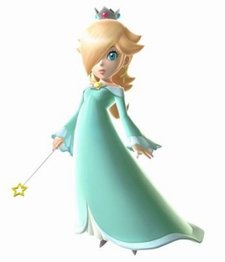 On another positive note, in addition to the inclusions of more cups and courses, Nintendo has added several new characters to the Mario Kart roster for Wii. There are 24 characters, four more than in GameCube’s Double Dash, as well as the option to race as your Mii. Some of the new additions are surprising (Princess Rosalina), some are a bit puzzling (Funky Kong) and some are awesome (Dry Bowser), but each is a welcome addition to a robust roster.
On another positive note, in addition to the inclusions of more cups and courses, Nintendo has added several new characters to the Mario Kart roster for Wii. There are 24 characters, four more than in GameCube’s Double Dash, as well as the option to race as your Mii. Some of the new additions are surprising (Princess Rosalina), some are a bit puzzling (Funky Kong) and some are awesome (Dry Bowser), but each is a welcome addition to a robust roster.
Visually, Mario Kart Wii is the stereotypical “mixed bag.” The game runs at a smooth 60 frames per second during single-player modes and online, a real accomplishment given the chaos of Mario Kart. The models are well done, and there are very pleasing effects sprinkled throughout the experience, including some nice particle effects as raceways wind through caves and volcanic hotbeds. Despite the simplicity of the graphics, most courses are explosively colorful and very appealing. The game is actually gorgeous when all these things come together; Rainbow Road, for example, is an absolute visual stunner. But otherwise, the landscapes are sometimes painfully dull and low-poly, literally comparable to GameCube’s Double Dash.
This has been a long review, but for good reason. Mario Kart has been one of Nintendo’s most prominent and beloved franchises for 16 years, and the Wii iteration marks some interesting changes for the franchise. While much remains the same, Nintendo has made some nice additions to the formula, but also unnecessarily pulled some features away. Because it can be infinitely entertaining, absolutely hysterical, rage-inducing, frustrating and spectacular all within the same hour, there is clearly a lot to say about Mario Kart Wii.
For its sensational track design, surprisingly fun motion controls and baffling deletions, Mario Kart Wii gets three stars out of four.

